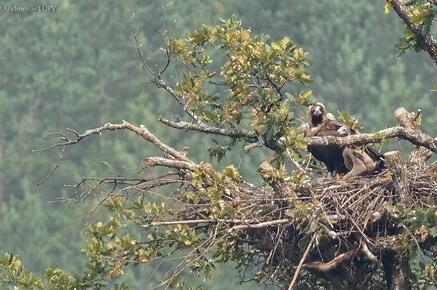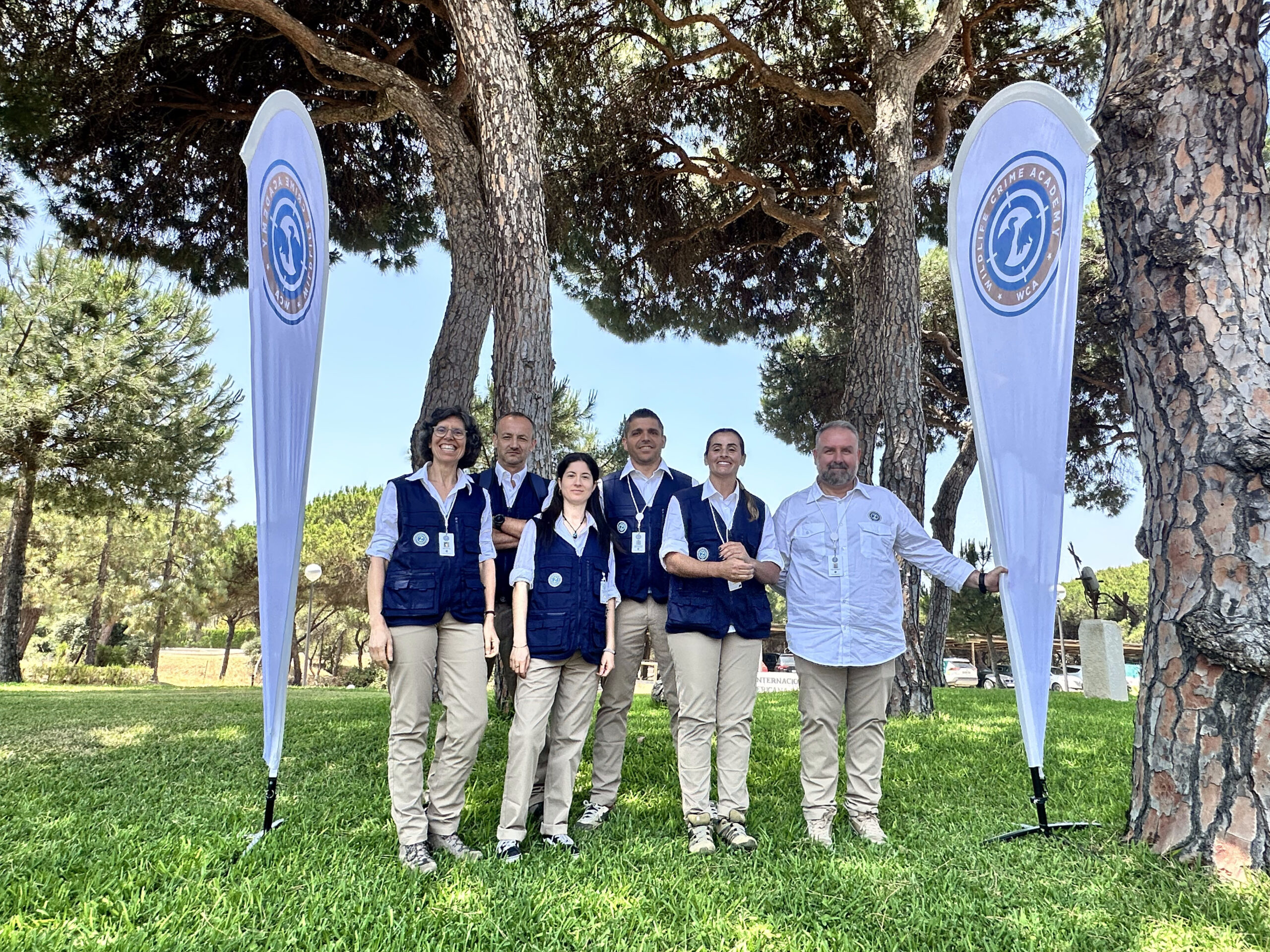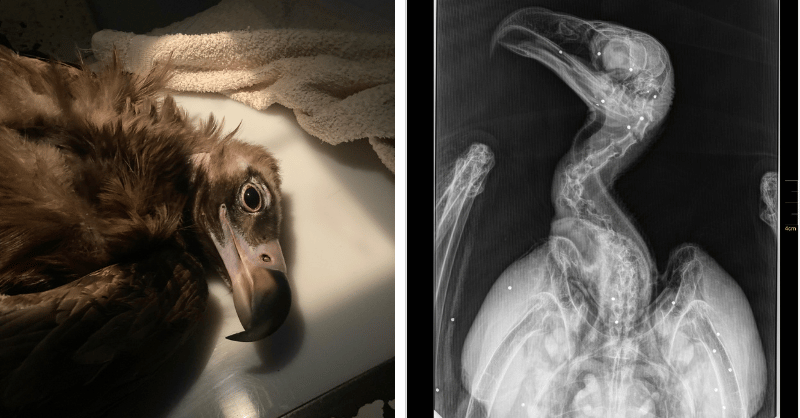For two days, partners of the LIFE Aegypius Return project gathered at Herdade da Contenda (Moura, Portugal) for the first NEEMO’s auditor visit. The meeting was an opportunity to share progress on the main actions implemented and discuss the preliminary results of this breeding season. The highlight of the meeting happened during the field trip, as we confirmed the presence of a new breeding pair – and even saw them mating!
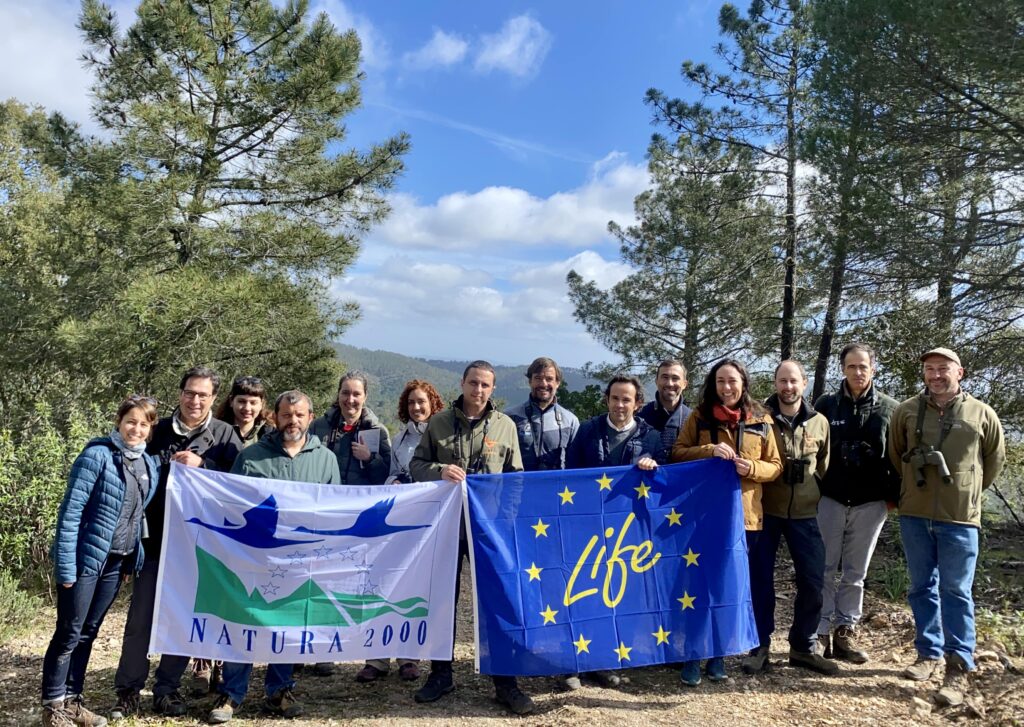
Consolidating and expanding the Cinereous Vulture population in Portugal
The Cinereous Vulture became extinct in Portugal in the 1970s and it was only in 2010 that the first pairs settled again in Portuguese territory to breed, thanks to conservation actions and the natural expansion of the species from Spain. From north to southern Portugal, there are today 40 breeding pairs, but potential habitat to host many more. The LIFE Aegypius Return project has the ambition to double the breeding population, promote connectivity between colonies and downgrade the national conservation status from Critically Endangered to Endangered.
Six months have passed since the project started, and we already have good reasons to celebrate. Our partners have been busy monitoring the existing breeding colonies across the border between Portugal and western Spain and exploring potential new breeding areas. In northern Portugal, two pairs are incubating; in central Portugal, in the Tejo valley, there is at least one new breeding pair confirmed, compared to last year; and in the south, at Herdade da Contenda, the number of breeding pairs just went up to 14.
During the field trip visit at Herdade da Contenda, apart from the many Cinereous Vultures that we saw crossing the skies, we had the chance to observe many natural nests and nesting platforms with the use of telescopes. From a long distance, to prevent any disturbance during this sensitive period, we saw three Cinereous Vultures incubating (there are currently 10 pairs incubating), which indicates they’ve successfully laid their egg for this season. The biggest surprise came from a nest that was still not confirmed, where we could see two individuals mating.
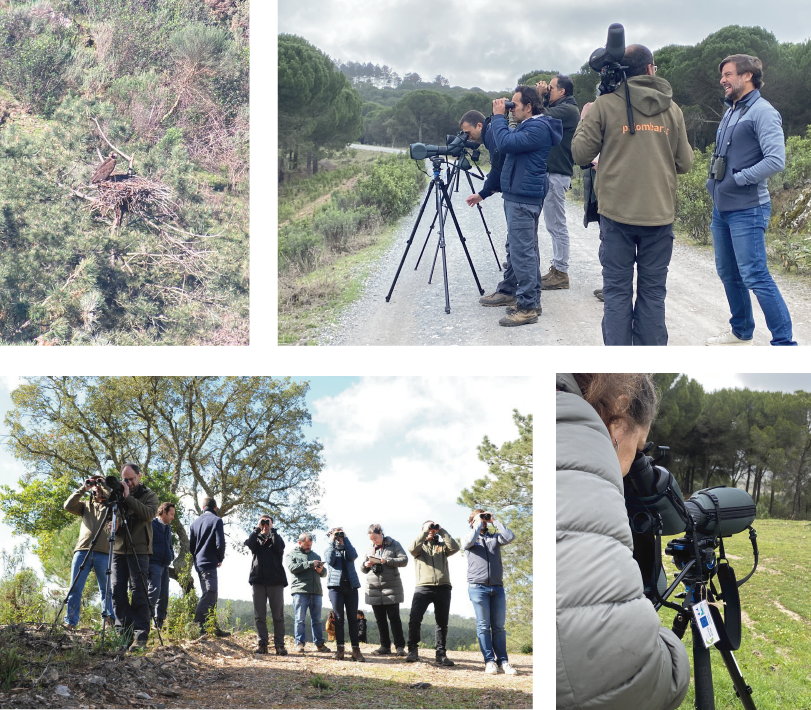
Building and repairing nests for the Cinereous Vulture
Cinereous Vultures build their huge nests on the top of trees or use artificial nesting platforms. In Herdade da Contenda, specifically, they tend to build their nests on pine trees, which are the most abundant species in the reserve. Earlier this year, our partners at LPN and Herdade da Contenda repaired some of the natural nests and nesting platforms and at least one is already being used by a pair.
Herdade da Contenda is home to the only breeding colony in southern Portugal. The first pairs settled in 2015 and the colony has been growing since then. Cinereous Vultures tend to return to the same nest every year with their life-long partner, and the number of pairs at Contenda was steady for the past seasons, with 10 pairs breeding. This season is very promising, as a new record of pairs has been confirmed.
Until the end of the project in 2027, partners will install 120 new nesting platforms in Portugal and western Spain, in areas with high breeding potential, and repair 105 natural nests. The field trip was also an opportunity to visit a nesting platform that is not being used this year and explain the technical knowledge and materials needed for the installation of these platforms.
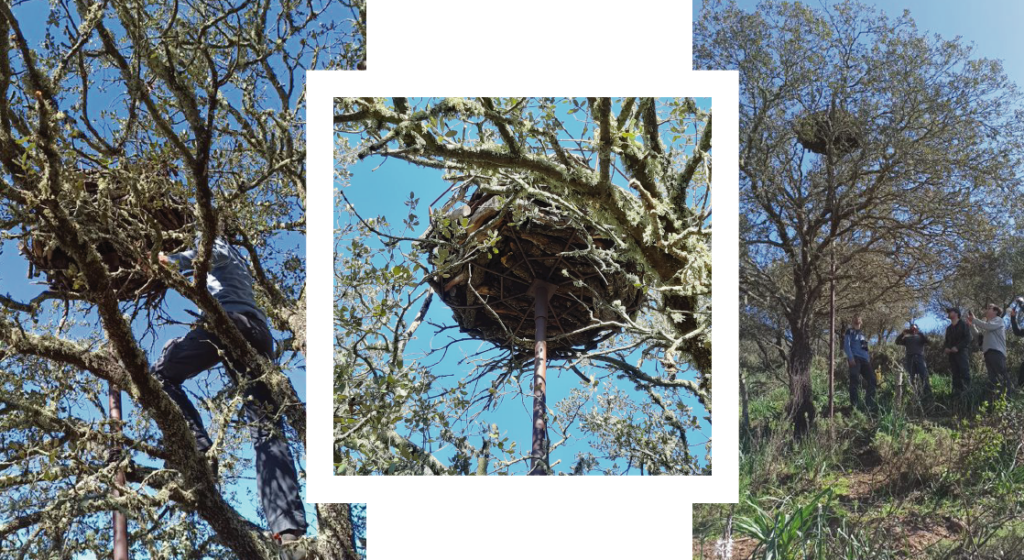
Maintaining feeding stations for the Cinereous Vulture
During the field trip, partners also had the chance to visit the vultures feeding station at Herdade da Contenda, a structure built in 2012, within other conservation projects, that has been maintained since then. The aim is to ensure food availability for the species, especially during the rearing period, but the food is deposited on an irregular basis, to mimic the natural patterns of food availability.
Carcasses, mainly coming from hunting and cattle-raising activities in the reserve, are torn apart into pieces and distributed within the 1 ha of the feeder station. The aim, Pedro Rocha (executive director at Herdade da Contenda) explains, is to prevent competition and increase the odds for each vulture to get his share, as Griffon Vultures are also regular visitors of this feeding station. Soon, it will be possible to use the brand-new hide installed on the edge of the station and see from close these magnificent birds feeding.
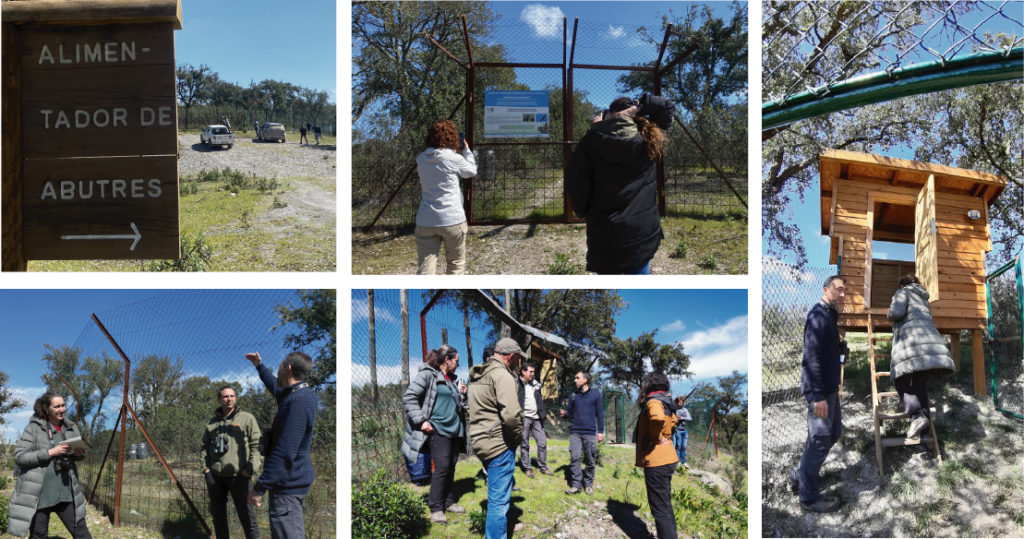
Working with hunters: new feeding stations and the transition from lead ammunition
The LIFE Aegypius Return will establish 66 new unfenced feeding areas, in straight collaboration with livestock farmers and game reserves, to improve food availability for the Cinereous Vulture. However, improving food availability for vultures is only worth it if we ensure it is not contaminated by lead ammunition.
During the project, the team will work with hunters in 14 game estates to support the transition to lead-free ammunition. At the meeting, we welcomed a ballistic expert, Pedro Vitorino (who is also the editor of the magazine Caça e Cães de Caça), who will support us in delivering the capacity-building sessions for hunters and game managers, planned for the next months.
Lead is a toxic component widely used in ammunition, that seriously affects nature and human health, and is lethal to vultures. On February 15, the use of lead ammunition became illegal in and around wetlands across all the EU 27 countries, Liechtenstein, Iceland and Norway, and a total phase-out is a possibility within the next years.
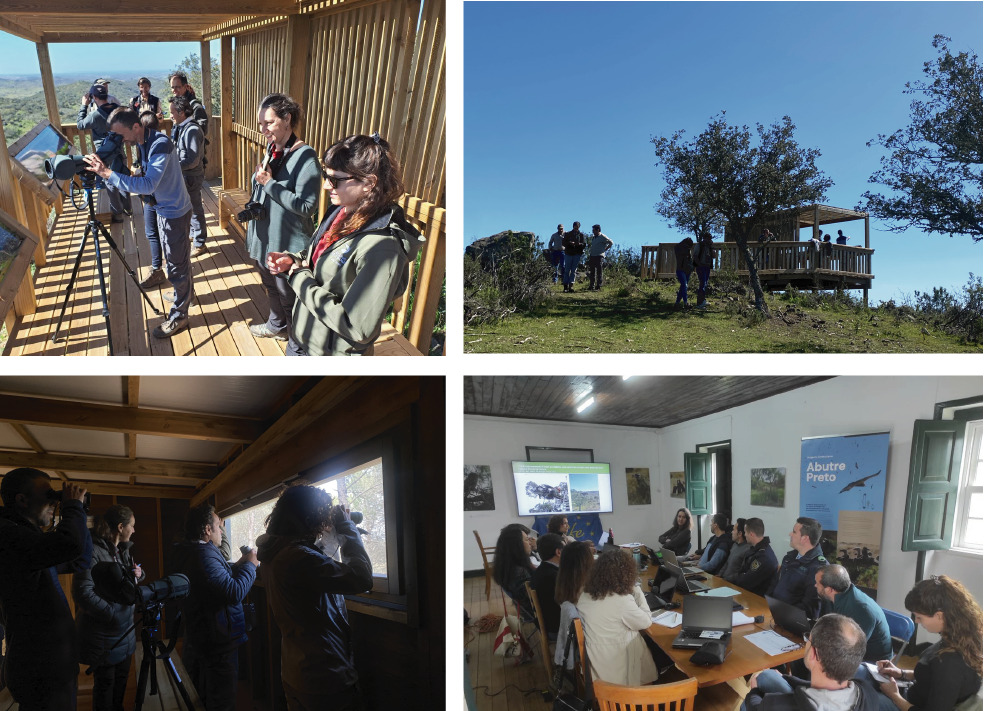
We would like to thank all partners for their commitment and excellent work. A special thank you to Herdade da Contenda for welcoming us and for taking care of all logistics.
The LIFE Aegypius Return Project

The LIFE Aegypius Return project has ambitious yet attainable goals to secure the comeback of the Cinereous Vulture in Portugal and western Spain. Until the end of the project in 2027, the team aims to double the breeding population in Portugal, encourage connectivity between colonies and downgrade the national conservation status from Critically Endangered to Endangered.
It is a 3.7 million project, co-financed by the European Union’s LIFE Programme, whose success relies on the involvement of all relevant stakeholders and the extensive collaboration of the leading project partner, the Vulture Conservation Foundation (VCF), with all local partners: Palombar – Conservação da Natureza e do Património Rural, Herdade da Contenda, Sociedade Portuguesa para o Estudo das Aves, Liga para a Proteção da Natureza, Associação Transumância e Natureza, Fundación Naturaleza y Hombre, Guarda Nacional Republicana e Associação Nacional de Proprietários Rurais and Associação Nacional de Proprietários Rurais Gestão Cinegética e Biodiversidade.


